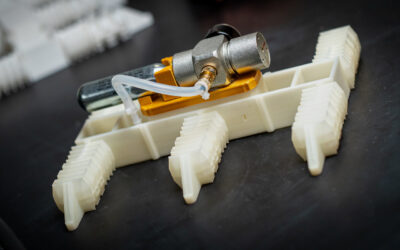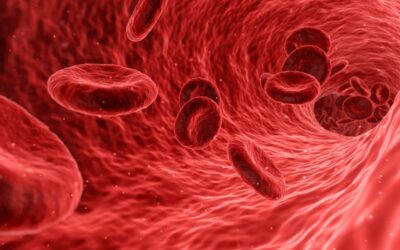This week's Advanced Materials Top 40 most-read articles features graphene, healthcare, and functional fibers inspired by spider silk.
 There’s lots of change this week in the Advanced Materials Top 40, with Michael Sailor’s review “Hybrid Nanoparticles for Detection and Treatment of Cancer” moving up 30 places from last week to take the top spot. A second review with a biomedical theme, “Mesoporous Silica Nanoparticles: Synthesis, Biocompatibility and Drug Delivery” by Fangqiong Tang, moves up 16 places into the top 10.
There’s lots of change this week in the Advanced Materials Top 40, with Michael Sailor’s review “Hybrid Nanoparticles for Detection and Treatment of Cancer” moving up 30 places from last week to take the top spot. A second review with a biomedical theme, “Mesoporous Silica Nanoparticles: Synthesis, Biocompatibility and Drug Delivery” by Fangqiong Tang, moves up 16 places into the top 10.
(For more healthcare-related materials science, read the virtual issue on Biomedical Materials and Applications, and be sure to take advantage of a free subscription to the new journal Advanced Healthcare Materials.)
Also of note this week:
| Rank |
Article |
Position last week |
Change |
Weeks in the Top 40 |
| 1 |
Hybrid Nanoparticles for Detection and Treatment of Cancer |
31 |
+30 |
2 |
| 2 |
Highly Stretchable and Highly Conductive Metal Electrode by Very Long Metal Nanowire Percolation Net |
|
|
1 |
| 3 |
Paper-Based, Capacitive Touch Pads |
4 |
+1 |
3 |
| 4 |
Novel Highly Conductive and Transparent Graphene-Based Conductors |
1 |
–3 |
4 |
| 5 |
Towards Textile Energy Storage from Cotton T-Shirts |
3 |
–2 |
2 |
| 6 |
Mesoporous Silica Nanoparticles: Synthesis, Biocompatibility and Drug Delivery |
22 |
+16 |
3 |
| 7 |
Direct Synthesis of Anatase TiO2 Nanowires with Enhanced Photocatalytic Activity |
14 |
+7 |
4 |
| 8 |
Graphene and Graphene Oxide: Synthesis, Properties, and Applications |
12 |
+4 |
3 |
| 9 |
Co-Evaporated Bulk Heterojunction Solar Cells with >6.0% Efficiency |
15 |
+6 |
2 |
| 10 |
Nanosheet-Constructed Porous TiO2 for Advanced Lithium Ion Batteries |
7 |
–3 |
2 |
| 11 |
Oxide Semiconductor Thin-Film Transistors: A Review of Recent Advances |
10 |
–1 |
3 |
| 12 |
Whitesides’ Group: Writing a Paper |
24 |
+12 |
3 |
| 13 |
Templating Assembly of Multifunctional Hybrid Colloidal Spheres |
2 |
–11 |
2 |
| 14 |
Stretchable Light-Emitting Electrochemical Cells Using an Elastomeric Emissive Material |
6 |
–8 |
2 |
| 15 |
Air-Stable and High-Mobility n-Channel Organic Transistors Based on Small-Molecule/Polymer S |
27 |
+12 |
2 |
| 16 |
For the Bright Future-Bulk Heterojunction Polymer Solar Cells with Power Conversion Efficiency of |
37 |
+21 |
3 |
| 17 |
One-Step Interfacial Synthesis and Assembly of Ultrathin Luminescent AuNPs/Silica Membranes |
13 |
–4 |
2 |
| 18 |
Graphene-Based Materials for Energy Conversion |
8 |
–10 |
3 |
| 19 |
Graphene Oxide as an Optical Biosensing Platform |
|
|
1 |
| 20 |
One-Dimensional Nanostructures: Synthesis, Characterization, and Applications |
|
|
1 |
| 21 |
Dual Plasmonic Nanostructures for High Performance Inverted Organic Solar Cells |
16 |
–5 |
3 |
| 22 |
Graphene Oxide as a Novel Nanoplatform for Enhancement of Aggregation-Induced Emission of Silole F |
21 |
–1 |
2 |
| 23 |
Random Composites of Nickel Networks Supported by Porous Alumina Toward Double Negative Materials |
|
|
1 |
| 24 |
Carbon Nanofibers Prepared via Electrospinning |
|
|
2 |
| 25 |
Functional Fibers with Unique Wettability Inspired by Spider Silks |
9 |
–16 |
2 |
| 26 |
Thiazole-Based Organic Semiconductors for Organic Electronics |
19 |
–7 |
3 |
| 27 |
A Self-healing Conductive Ink |
34 |
+7 |
3 |
| 28 |
A Crown Ether Appended Super Gelator with Multiple Stimulus Responsiveness |
|
|
1 |
| 29 |
Functional Fibers: Functional Fibers with Unique Wettability Inspired by Spider Silks (Adv. Mater. 2 |
23 |
–6 |
2 |
| 30 |
Efficient, Large Area ITO-and-PEDOT-free Organic Solar Cell Sub-modules |
|
|
1 |
| 31 |
Flexible, Angle-Independent, Structural Color Reflectors Inspired by Morpho Butterfly Wings |
38 |
+7 |
3 |
| 32 |
Bioinspired Layered Composites Based on Flattened Double-Walled Carbon Nanotubes |
|
|
1 |
| 33 |
High-Efficiency Inverted Polymer Solar Cells with Transparent and Work-Function Tunable MoO3-A |
30 |
–3 |
2 |
| 34 |
Enhancement in the Performance of Ultrathin Hematite Photoanode for Water Splitting by an Oxide Unde |
25 |
–9 |
2 |
| 35 |
Flexible Control of Block Copolymer Directed Self-Assembly using Small, Topographical Templates: P |
|
|
2 |
| 36 |
Nano-photocatalytic Materials: Possibilities and Challenges |
|
|
1 |
| 37 |
Highly Efficient Single-Layer Polymer Ambipolar Light-Emitting Field-Effect Transistors |
28 |
–9 |
2 |
| 38 |
Understanding Charge Transfer at PbS-Decorated Graphene Surfaces toward a Tunable Photosensor |
29 |
–9 |
2 |
| 39 |
Electrospinning of Nanofibers: Reinventing the Wheel? |
|
|
1 |
| 40 |
Design Rules for Donors in Bulk-Heterojunction Solar Cells: Towards 10% Energy-Conversion Ef |
|
|
1 |
 There’s lots of change this week in the Advanced Materials Top 40, with Michael Sailor’s review “Hybrid Nanoparticles for Detection and Treatment of Cancer” moving up 30 places from last week to take the top spot. A second review with a biomedical theme, “Mesoporous Silica Nanoparticles: Synthesis, Biocompatibility and Drug Delivery” by Fangqiong Tang, moves up 16 places into the top 10.
There’s lots of change this week in the Advanced Materials Top 40, with Michael Sailor’s review “Hybrid Nanoparticles for Detection and Treatment of Cancer” moving up 30 places from last week to take the top spot. A second review with a biomedical theme, “Mesoporous Silica Nanoparticles: Synthesis, Biocompatibility and Drug Delivery” by Fangqiong Tang, moves up 16 places into the top 10.
















